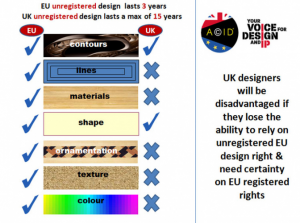This article is written by Ch. Leela Madhuri, pursuing a Diploma in Intellectual Property, Media, and Entertainment Laws from Lawsikho.com.
Table of Contents
Introduction
British design makes an important and considerable contribution to the economy. The government identifies that it’s a neighbourhood of possible growth. The designs command within the UK is honestly difficult and covers a variety of various rights. As there is a connection between these different rights, one product can be covered by quite one design right at a time. Earlier on intellectual property achievement day, there have been four design rights available within the UK. They are UK registered design rights, UK unregistered design rights, registered community designs (RCDs), and unregistered community designs (UCDs). This design rights help in protecting the designer’s designs with no infringements. Those that depend upon the unregistered UK or EU design rights that too if they are members of ACID (Anti Copying in Designs) then they will send their designs into the FREE and unlimited use of the ACID Design Data Bank to offer dated evidence of the start of styles, arenas, and offers. This article talks about how Britain protects unregistered design rights.
What are design rights?
Design protections have taken on an increasingly important role in recent years since their arrival and external shape now plays a fundamental role within the success of a product. Designs are now applicable to a good range of products involving industry, fashion, and crafts, and must be protected to ensure the creator’s moral and financial benefits. Design rights protect the way a product looks. If the planning features a technical function or the appearance of the product comes naturally as a result of the function that it performs, then a design right might not be suitable. Designs were originally protected as artistic creations under the support of copyright law. As society began to acknowledge the worth in several sorts of creativity, from books to fabrics to fine arts, and as technological developments simplified copying of these different art forms, the law responded during a disjointed fashion, consulting copyright protection upon whichever sorts of the design was under threat at the time. Design can have an excellent influence on the marketable success of a product. For a few products, the design could also be the sole characteristic feature. Therefore, it is important for businesses that depend on the design to make sure that they need legal protection for the looks of their products.
The EU Commanded national design protection rules across all EU Member States by requiring them to guard designs by registration and to define design because the appearance of the entire or a neighbourhood of a product resulting from the features of the lines, outlines, colours, shape, texture or its ornamentation. To receive protection, the planning must be innovative and have its only character. During this situation, innovation means that there are not any identical designs already available to the general public. A design has individual character if the entire impression, from an informed user’s point of view, is different from other designs available to the general public. Under UK national law, there are two types of protection available for designs, which are unregistered design rights and registered designs rights.
About registered and unregistered designs
The register rights are attained through an application procedure, and unregistered rights can arise automatically once a design has been recorded but generally provide weaker protection compared to register rights. A registered design may be a monopoly right approved by the government. An identical design employed by a competitor may infringe regardless of whether it is a replica. If protection is required out of the country, then corresponding registrations could also be obtained to support the United Kingdom application. Whereas an unregistered design right is extremely limited. It can only be imposed if it is often shown that the assumed infringer copied the planning. And an identical design created independently does not infringe. Design right is not automatically available to all or any designers worldwide.
After adopting the EU Instruction, which already provided rights for registered designs, the European Union decreed EU Regulation, which executed a placement, unique design right covering unregistered designs within the EU. The EU Regulation resulted in two sorts of EU design rights referred to as registered community designs (RCDs) and unregistered community designs (UCDs). Registered and unregistered community designs are having the funds for different rights within the EU. A registered community design right may protect the looks of a product or a part of a product. The appearance may result from the form, lines, contours, ornamentation, colours, texture, or materials of the merchandise. during this context, a product means any industrial or handicraft item except a computer virus and includes parts intended to be assembled into a posh product, packaging, get-up, graphic symbols or, fonts. Whereas unregistered community designs are useful in protecting short-life products like products within the style industry in the light of the very fact that the registration process is often costly. These UCD (Unregistered Design Rights) are available to a person, or company, regardless of nationality.
Protection of unregistered designs in Britain
The United Kingdom’s unregistered design rights have their own and individual origin from the Copyright, Designs and Patents Act 1988 (CDPA) and are not matched by EU law. Unregistered design rights are essential rights within the protection of a design, from the starting time the planning is first recorded in either a design document or a piece of writing is formed to the planning. For a design to be qualified for cover under UK unregistered design, it must be a unique design. This means that the design must be created by the designer, not be a replica of a common one within the design field within the query which is quite an unimportant step of skill, work, and, the choice was involved within the creation of the planning. UK unregistered design right only protects the planning right holder from third parties copying the planning. Hence, within the event the assumed infringer can show that they are here at the planning independently, they are not going to be held to infringe. Basically, only the creator of the original owner of the unregistered design right within the design is understood to be the designer. It is not applicable unless the design is formed during the course of employment, during which instance where the creator of the primary owner is that the employer.
UK unregistered design right protects the design for ten years from the top of the civil year during which articles thereto design were first placed on the market, or for 15 years from the top of the civil year during which the planning was recorded in a design document, either period expires first. Two-dimensional designs are not protected by UK unregistered design rights, though designs for curtain fabric, wallpaper, or similar could also be protected as copyright artistic works. Community unregistered design rights offer protection for less than three years for qualifying designs, the three years running from the date it had been first made available to the general public within the community. This is often referred to as supplementary unregistered design rights or continuing unregistered community design. The scope of what is often protected under a community unregistered design right is suggestively different from what can be protected under UK unregistered design right. For instance, community unregistered design rights can cover designs of colour, texture, and materials. It is focused on protecting the presence of a product and can include two-dimensional designs. It protects designs that are new and have individual character.
Conclusion
Therefore, by this text, one can understand clearly that the United Kingdom government with the assistance of the supplementary unregistered design right protects the appearances of the unregistered designs also alongside the designs. Actually, in both registered design rights and unregistered design rights, the plaintiff may pursue damages or accounts of the returns, or an injunction trying to find for further violation. UK design law also offers for a UK unregistered design right under the CDPA, but it does not just match the registered community design right, which can be of concern post Brexit. An unregistered design right holder must avoid the copying of the planning by the third party with the intention of commercially producing articles that are identical or considerably almost like the planning. So, that it is going to help in the decline of the conflict of infringement. The bulk of UK unregistered design rights protects any new design of the entire or a part of a piece of writing, as long in the light of the fact it is not common within the related practical field, is protectable intentionally right.
Reference
- https://www.ouryclark.com/resource-library/quick-guides/intellectual-property/design-rights.html
- https://hjsolicitors.co.uk/article/registered-design-rights-faqs/
- https://www.bl.uk/business-and-ip-centre/articles/whats-the-difference-between-unregistered-design-right-and-design-registration
- https://www.worldtrademarkreview.com/portfolio-management/protecting-and-enforcing-design-rights-united-kingdom
- https://www.gov.uk/unregistered-designs
- https://ipcopy.blog/2016/08/23/uk-unregistered-design-right-a-brief-guide/
- https://www.mewburn.com/law-practice-library/uk-eu-unregistered-designs-the-basics
Students of Lawsikho courses regularly produce writing assignments and work on practical exercises as a part of their coursework and develop themselves in real-life practical skills.
LawSikho has created a telegram group for exchanging legal knowledge, referrals, and various opportunities. You can click on this link and join:
 Serato DJ Crack 2025Serato DJ PRO Crack
Serato DJ Crack 2025Serato DJ PRO Crack












 Allow notifications
Allow notifications



